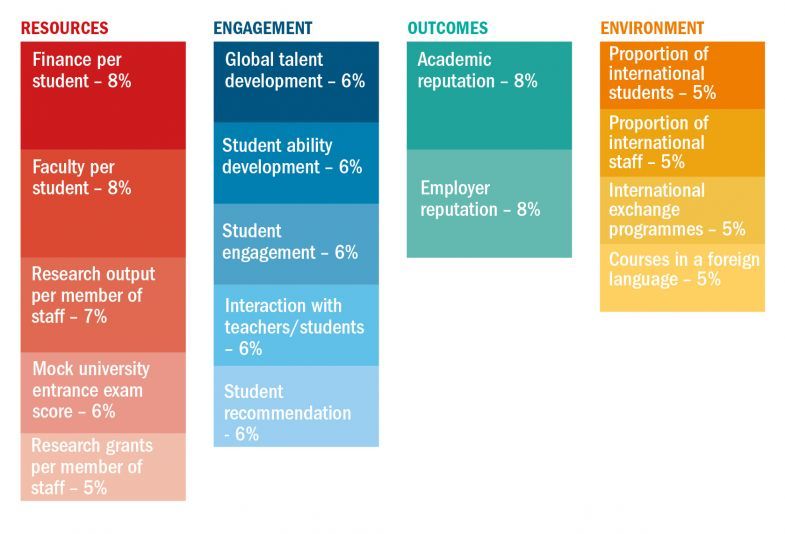Browse the THE Japan University Rankings 2020 results
The Times Higher Education Japan University Rankings use a balanced scorecard approach, with 16 individual performance indicators combining to create an overall score that reflects the broad strength of an institution. The overall methodology explores four key areas, which we call pillars:
Resources
This pillar includes metrics on finance (income) per student (8%), which show whether the institution has the money to effectively deliver teaching, and the ratio of faculty members to students (8%), which gives a sense of whether the college has enough teachers to teach. We also look at the scholarly output (7%) and research grants per member of staff (5%) at each institution. Having faculty who are experts in their academic fields can significantly enhance a student’s educational experience. The final metric measures the national mock university exam scores (6%) received by institutions’ entrants to get an indication of the academic calibre required to gain admission to a particular university and its popularity among top students.
Engagement
This pillar measures opinions of the university from two sources: the High School Advisors Survey, and the Japan Student Survey. The High School Advisors Survey gathers the views of student careers advisers from almost 2,200 Japanese secondary schools. It asks advisers to name the top 15 universities that they believe teach students to the highest global standards (6%), and the 15 universities that they think are best at developing students’ abilities (6%). We are also using data from the last two years of our student survey, which is based on the same model used in our other Teaching Rankings (US, Europe). Responses to seven questions are used in three metrics in the following manner:
- The engagement metric (6%) uses scores from four questions, asking to what extent teaching at the university (1) supports critical thinking, (2) supports making connections among the things students have learnt, (3) supports applying the students’ learning to the real world and (4) offers classes that challenge the students.
- The interaction metric (6%) uses scores from two questions, asking how many opportunities the students had to (1) interact with the staff and faculty and (2) collaborate with their peers.
- The recommendation metric (6%) uses scores from one question, which asks how likely students would be to recommend their university to friends or family.
Outcomes
This pillar looks at the overall academic reputation (8%) of the university in Japan, based on votes from Japanese scholars in THE’s annual Academic Reputation Survey of leading academics worldwide, which helps us to determine which institutions have the best reputation for excellence in teaching. We also consider the reputation of the university among employers (8%) to get a sense of whether the university produces graduates the market wants. This is based on a survey of human resources departments from 815 listed and non-listed companies. Each department was asked to identify the 10 best universities based on the strengths of their employees from those institutions. Each department then completed a survey for each of the 10 universities that it identified, rating the employees from these institutions in several areas.
Environment
This pillar looks at the make-up of the student and staff body at each campus, helping students to determine whether they will find themselves in a diverse, supportive and inclusive university environment. We examine the proportion of international students (5%) and international staff (5%) on campus, which are key indicators of whether the university is able to attract talent from across the world. It also demonstrates which institutions have cultivated a multicultural campus where students from different backgrounds have the opportunity to learn from one another. We are also looking at two dimensions of internationalisation: the number of students in various types of international exchange programmes (5%), and the number of courses taught in a language other than Japanese (5%).

Explore our portfolio of global university rankings
Data for the rankings come from a variety of sources. These include self-submitted data from the institutions themselves as well as data gathered from Elsevier, Benesse Corporation, Nikkei Human Resources, the Japanese government and the Times Higher Education Academic Reputation Survey. Our data are, in most cases, normalised so that the value we assign in each metric can be compared sensibly with other metrics. The calculation of the THE Japan University Rankings has been subject to independent audit by professional services firm PricewaterhouseCoopers (PwC). Read more about the PwC/Times Higher Education Japan University Rankings 2020 report here.
请先注册再继续
为何要注册?
- 注册是免费的,而且十分便捷
- 注册成功后,您每月可免费阅读3篇文章
- 订阅我们的邮件
已经注册或者是已订阅?

